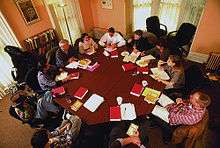Oxford Annotated Bible

The Oxford Annotated Bible (OAB) is a study Bible published by the Oxford University Press (OUP). The notes and the study material feature in-depth academic research from non-denominational perspectives, specifically secular perspectives for "Bible-as-literature" with a focus on the most recent advances in historical criticism and related disciplines, with contributors from mainline Protestant, Roman Catholic, Jewish, and non-religious interpretative traditions.
Editions and Biblical versions
The first edition of the OAB, edited by Herbert G. May and Bruce Metzger, was published in 1962, based on the Revised Standard Version (RSV) of the Bible.[1][2] In 1965, OUP published a matching edition of the deuterocanonical and apocryphal books as well as a version of the OAB including them.[1] The deuterocanonical books are used by the Roman Catholic Church and the Greek and Slavonic Orthodox Churches, as well as churches of the Anglican Communion (including The Episcopal Church). In the same year, the OAB received the official imprimatur of Cardinal Richard Cushing for use as a Roman Catholic study bible.[3][2] Later, the NOAB was also warmly welcomed by Orthodox leaders.[4]
The first edition of the New Oxford Annotated Bible (NOAB), was published in 1973, still based on the Revised Standard Version (RSV) of the Bible.[1][2] After the release of the New Revised Standard Version (NRSV) of the Bible in 1989, OUP published a second edition of the NOAB based on that translation. The NRSV was also the basis of the third edition (2000), edited by Michael Coogan, which is considered to be much more ecumenical in approach. For example, it calls the Old Testament the "Hebrew Bible" out of consideration to Jewish readers.
In addition to the NRSV editions, OUP continues to make the 1977 RSV edition available.[5]
The OAB also includes a number of interpretive essays. Essay topics include Bible translations, early Jewish history and the geography of the Bible. The NOAB also features maps of the Holy Land during various time periods. The NOAB is commonly used by colleges and universities.
A fully revised Fourth Edition was released in May 2010. It contains new color maps and updated essays and commentaries. As always, versions with and without the Apocrypha were made available.
A fully revised Fifth Edition was released on 1 April 2018 with similar improvements.
Some groups, including fundamentalist and evangelical Protestants as well as traditional Catholics, object to the OAB because the editors adhere to contemporary, scholarly views of Biblical criticism, and thus call into question the traditional authorship of some books.
 Students at Shimer College discussing the New Oxford Annotated Bible
Students at Shimer College discussing the New Oxford Annotated Bible The 1973 edition of the New Oxford Annotated Bible, with the RSV text
The 1973 edition of the New Oxford Annotated Bible, with the RSV text Copies of a 1994 edition of the NOAB in a discussion class
Copies of a 1994 edition of the NOAB in a discussion class The 2000 edition of the New Oxford Annotated Bible, with the NRSV text
The 2000 edition of the New Oxford Annotated Bible, with the NRSV text
Works cited
- Metzger, Bruce (1995). Reminiscences of an Octogenarian. ISBN 9780801047138.
- May, H.G. (1974). "The Revised Standard Version Bible". Hammershaimb: 1904-1974. ISBN 9789004039100.
References
- 1 2 3 Metzger 1995, p. 80.
- 1 2 3 May 1975, p. 239.
- ↑ Metzger 1995, pp. 80-81.
- ↑ Metzger 1995, p. 81.
- ↑ "The New Oxford Annotated Bible with the Apocrypha, Revised Standard Version, Expanded Ed". Oxford University Press. Retrieved 2014-12-29.